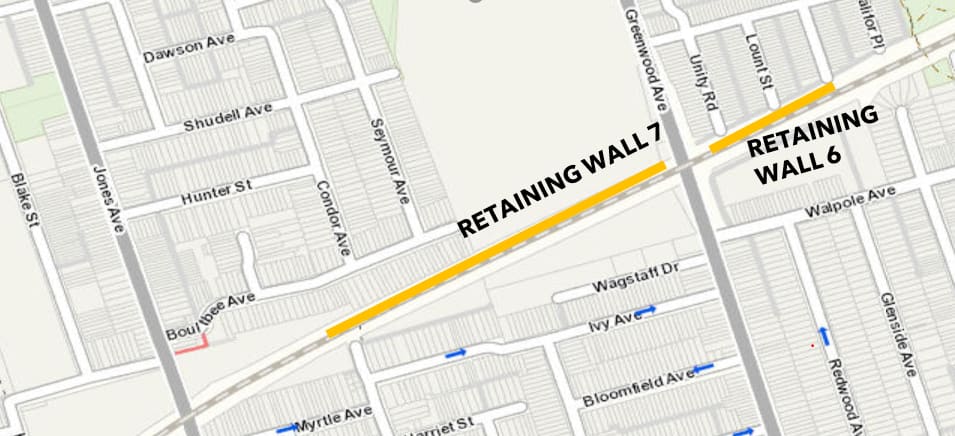Night work starting on GO tracks between Jones Ave & Coxwell Ave
The work will support future service expansion on the Lakeshore East GO Line
Sep 15, 2021
Construction has been quiet between Jones Avenue and Coxwell Avenue along the Lakeshore East line lately.
Next week, crews will be resuming work as part of the preparatory early work on the Lakeshore East Rail Corridor Expansion project in Toronto. This expansion project will enable the future addition of a fourth track and electrification infrastructure – meaning quieter, faster, more efficient service for customers. The new fourth track will improve journey times for all transit trips on the Lakeshore East Corridor, improve reliability and allow Metrolinx to deliver more service within the City of Toronto.
Metrolinx recognizes construction in neighbourhoods is challenging, especially overnight work, and will be putting every effort in place to minimize disruptions where possible.
The work this fall will focus on the construction of two pile and lagging retaining walls, one east and one west of Greenwood Avenue. The walls carry and support the weight of the ground, where there is a difference in ground elevation and minimize the width of the future rail corridor. They are designed to hold up soil and earth to stabilize uneven ground on the north side of the rail corridor that will be graded for the future fourth track.
Crews will be constructing retaining walls east and west of Greenwood Avenue. (Metrolinx image)
Installation of retaining walls is heavy work and Metrolinx is installing infrastructure that will last for generations. In this location piles are being drilled and this approach is quieter and less disruptive than driven piles, which are hammered or pounded into the ground.
Work to build a pile and lagging wall includes vegetation removal, moving earth, drilling piles (vertical), caisson installation (structures necessary to pump out water/moisture to create suitable working conditions for retaining wall works) and lagging installation (horizontal material of the wall to hold back earth). Some trees that specifically interfered with the construction of the retaining walls and future fourth track have already been removed. Only a minimum number of trees will be removed to allow crews to work safely, and fencing will also be installed to protect surrounding trees.
More Vehicles
As construction begins, residents will notice some increased vehicles and equipment in the area. Concrete trucks are used to deliver concrete to the site which gets placed in the caisson. Dump trucks will help move dirt around and on- or off-site. Dozers will push and shape the dirt. And finally, rollers will be brought in to compact the earth as drill rigs will help install the piles in the ground.
Vehicles, machinery and workers will access the corridor through Unity Road and the work will occur at night between the hours of 7 p.m. and 7 a.m., five days a week, Monday to Friday. The work for retaining walls six and seven are anticipated to be complete by fall 2022.
Vehicles, machinery and workers will access the corridor via Unity Road. (Metrolinx image)
Night Work
Night work is required due to the active rail corridor and work must take place when trains are not running to keep our crews safe and productive because of the proximity of the tracks.
To reduce noise, crews will minimize reverse operations, use broadband – it’s ‘white noise’ – back up alarms on trucks and equipment, and ensure no idling of non-essential equipment. Noise and vibration will also be monitored to ensure work is within limits.
“Metrolinx’s Toronto East Community Relations team is dedicated to providing timely updates to the community including regular Construction Liaison Committee (CLC) meetings” said David Phalp Metrolinx senior manager for Community Relations.
“We will do our best to keep the noise down and disruptions to a minimum where possible.”
Work on these retaining walls is part of the Lakeshore East Rail Corridor Expansion project in Toronto, which includes grading, retaining walls, constructing a new culvert and bridge widening to accommodate a future fourth track. By building on what is there today, Metrolinx can improve infrastructure that will deliver faster, two-way, all-day, 15-minute service on core segments of the network.
For the latest information on what’s happening in your area, register for the weekly electronic newsletter at metrolinx.com/lakeshoreeastrailcorridor and follow the team on Twitter @GOExpansion. Questions and concerns will be answered by community relations staff and can be reached at TorontoEast@Metrolinx.com
by Teresa Ko Metrolinx communications senior advisor
